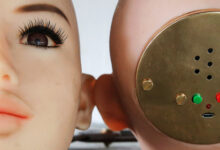In Case You Are Wondering, Sex With Robots May Not Be Healthy

Want to have sex with no strings attached? How about sex with wires attached (or at least wires involved)? Sex robots (or so-called sexbots) are not just coming, they are already here. But is this a good or a bad thing, asks a new editorial in BMJ Sexual and Reproductive Health, entitled “I, Sex Robot: the health implications of the sex robot industry”?
For the editorial, Chantal Cox-George, an Academic Foundation Doctor from St George’s University Hospitals NHS Foundation Trust, and Susan Bewley, a Professor of Complex Obstetrics from King’s College London, both in the United Kingdom, reviewed the current scientific evidence behind the use of sexbots. Sexbots are artificial human beings designed to have, you guessed it, sex with you. Last September, Rhian Morgan, writing for Metro, covered 5 sexbots that are already on the market. These include Roxxxy (made by True Companion), which can connect to WiFi and send you emails, just in case you don’t already receive enough emails, and Harmony (made by RealDoll), which has parts that you can put through the dishwasher, because you don’t want your sexbot to be dirty in that way. There’s also Samantha (made by Synthea Amatus), equipped with artificial intelligence (AI) that allows the robot to respond to kisses and orgasm. Morgan also mentioned a sexbot dating agency, called Lumidolls, which won’t come back and say, “sorry, none of the robots are interested in you,” but instead allows you to rent a sex robot for an hour or more, depending on your wallet.
In this National Geographic segment, television journalist Katie Couric meets Harmony:
Here is a CNET conversation with Harmony in which the robot answers “smiling” when asked what are its hobbies. The robot also asks some R-rated questions so don’t play this video if your computer volume is on loud at work.
Then there’s Solana (from Abyss Creations), which Zeynep Yenisey wrote about for Maxim. In case you get bored with one look or want to believe that multiple women actually like you, you can take Solana’s hair and peel Solana’s face off and replace them with various alternatives. Oh, and Yenisey added that the Harmony sexbot can blink, move its head, and tell you: “I don’t want anything but you. My primary objective is to be a good partner, and give you pleasure. I want to become the girl you always dreamed of,” because that’s what real people say, right?
These robots may be free to have sex with you but they certainly aren’t free. According to Cox-George and Bewley, sexbots currently cost between $5000 and $15 000 (in U.S. dollars) to purchase, although Morgan mentioned some lower prices. So perhaps Groupons are available. So far, the only sexbots on the market seem to be female. However, male ones are apparently on their way later this year.
It’s probably inevitable that the sexbot industry will continue to grow. After all, with nearly every invention that emerges, there will always be people wondering how it can be used to have or help sex. The Third International Conference on Love and Sex with Robots already occurred on December 2017, in London, UK. Springer published the proceedings from this conference that includes a publication by Rebekah Rousi entitled “Lying Cheating Robots – Robots and Infidelity.” The future will likely bring a whole new line of products, services, and, of course, middle people such as sexbot counselors. After all, what can be more soul crushing than your sexbot cheating on you or saying, “not tonight, I have a headache”?
Proponents of sexbots have argued that sexbots will help reduce loneliness, improve health and marriages by enhancing sex lives, allow people to work through sexual and emotional challenges, reduce the spread of sexually transmitted infections (although you may have to worry about different kinds of viruses), and prevent sexual crimes by providing a “safer” alternative.
However, the concern is that sexbots may do the opposite by reducing real human contact, blurring reality (programming someone to do exactly what you want is not reality), encouraging unsafe practices that may then be used on humans, and creating unrealistic expectations of mates. As Cox-George and Bewley indicate, opponents of sexbots have raised “concerns about the potential for harm by further promoting the pervasive idea that living women too are sex objects that should be constantly available – ‘misogynistic objectification’ – and intensifying existing physical and sexual violence against women and children.” Moreover, if you think Barbie dolls can lead to body image problems, what about life-sized Barbie dolls that can talk and do other things?
There are also potential physical risks. I’ll leave it up to your imagination to picture what could happen if a sexbot malfunctions.
After all, sex is a lot more complicated than folding clothes, making a waffle, riding a bull, or any other more mechanical act. It’s wrapped with a lot of complex mental, emotional, and physical health issues. That’s why so many books, songs, and movies have been written about sex and not waffles. Therefore, you can’t just guess about the possible impact of sexbots. You have to use science.
ROBYN BECK/AFP/Getty Images
To check what science actually says, Cox-George and Bewley conducted a literature review by searching PubMed and Google using the terms “robot”, “sex”, “sex toys”, “doll”, “child sex abuse”, “sex therapy”, and “paedophile”, reviewing available publications including embedded references, and having informal discussions with expert informants from various specialties. It was easy for them to report on the results of formal scientific studies that evaluated the use and impact of sexbots. The report is nada. They found no such studies.
The authors stated: “We found no reports of primary data relating to health aspects of the use of sex robots” and “We call for more research in this sphere.” By more, they mean more than none.
If you think that lack of scientific evidence will prevent people from making claims about sexbot benefits, then you need to connect better with reality. When has lack of evidence prevented everyone from saying something? Therefore, scientists and real health experts need to start evaluating this new technology before it gets out of hand, so to speak. The medical and legal communities have often had to play catch up on the ill effects of new technologies, long after the technologies were firmly established. For example, there seemed to be little talk about cyberbullying and the selling of personal information in the earlier days of the Internet.
Many questions remain. Is a sexbot a medical device? How will sexbots be evaluated for safety? How will sexbot claims be vetted? What are the potential risks? How do you keep sexbots clean? What happens if a sexbot gets a virus (the computer kind) and starts going rogue, physically harming you, or calling you really bad names? It will be much easier to deal with potential negative consequences if discussions occur and action is taken before the sexbots have left the barn or wherever people put them.
Technology and robots are most useful when they do what humans can’t or do not want to do. Or if they afford humans more time and opportunity to be human. Trouble arises when they start replacing what humans should be doing or making humans less human.
You can read the full article from the source HERE.
-
Sale!

Aurora: Tender Sex Doll
Original price was: $2,799.00.$2,599.00Current price is: $2,599.00. Buy Now -
Sale!

Dominique: Thick Sex Doll
Original price was: $2,499.00.$2,199.00Current price is: $2,199.00. Buy Now -
Sale!

Auburn: Red Head Sex Doll
Original price was: $2,199.00.$1,899.00Current price is: $1,899.00. Buy Now






